Staking Ethereum (ETH) in Trezor Suite
Learn how to stake Ethereum (ETH) using your Trezor hardware wallet via the Trezor Suite application: the safest way to stake ETH with ease.
What is staking?
Staking is the process used for validating transactions on blockchains that use the Proof of Stake (PoS) consensus mechanism. Ethereum's switch from Proof of Work (PoW) to PoS through its upgrade to Ethereum 2.0 was motivated by several key factors, each aimed at improving the network's efficiency, security, and scalability. You can learn all about staking ETH by watching this video:
In general, a stake is defined as a share or financial involvement in a business, enterprise or service.
There are four classes of ETH staking:
- Staking as a validator: Requires a deposit of 32 ETH, and as a validator you will help maintain the integrity of the Ethereum network by storing data, processing transactions, and adding new blocks to the Ethereum blockchain. Naturally, this also requires proper hardware and technical knowledge.
- Staking as a service: Aimed at users who are perhaps less tech savvy but still want to stake 32 ETH and have a service validate on their behalf. This method requires a trustworthy provider and careful control of your keys.
- Pooled staking (as implemented in Trezor Suite): This method is ideal for users who either don't have or don't want to stake 32 ETH. Staking pools enable collaborative staking, which allows more users to stake smaller amounts to make up the 32 ETH required to activate a set of validator keys.
- Centralized exchanges: These run large numbers of validators by consolidating many staking pools. This is the riskiest approach, as you are not in control of your keys, and relies on the greatest trust assumptions.
Staking helps maintain the integrity of the Ethereum blockchain. Validators who misbehave (e.g. by failing to identify the head of the chain on time, or by double-signing transactions) risk losing ETH through a process known as slashing.
Staking ETH with Trezor
Ethereum staking is available on all Trezor devices (Trezor Model One, Model T, Safe 3, Safe 5, and Safe 7) and is accessible to users worldwide.
In Trezor Suite, the service is provided by a third party, Everstake. The funds are sent to Everstake to be staked via a smart contract. Everstake is a widely-used service that lets users stake their ETH without having to set up their own validator node. This makes the process much easier for everyday users, and negates the need for the 32 ETH requirement to become a full validator.
As staking is fully maintained by Everstake, Trezor assumes no responsbility if anything should happen to Everstake and, consequently, the funds delegated to their stake pool.
To stake ETH, you need a minimum of 0.1 ETH. You can't stake 100% of your ETH, as you must have enough left to cover gas fees. During the staking period, you can't trade your staked ETH.
When you stake, your ETH enters the Everstake staking pool. Your funds are usually staked instantly if others are entering and exiting the pool at the same time. If not, entering the pool can take up to 24 hours.
When staking ETH via Trezor, the funds are sent to the Everstake staking pool.
Retrieving your ETH and rewards from the stake pool consists of two steps: unstaking and claiming. Unstaking does not have a set time-frame and is dependent on network conditions. After the unstaking step is complete, the ETH and any rewards can be claimed instantly.
While unstaking as a solo validator should be done with caution, unstaking as part of a pool can be done at any time. Where possible, ETH will be instantly unstaked if there are funds entering and exiting the pool simultaneously. For example, if a user unstakes 5 ETH and 1 ETH is available, the user automatically gets 1 ETH but needs to wait for the remaining 4 ETH.
Why stake Ethereum?
Staking ETH benefits both the network and individual users. By staking ETH, validators help secure the network. The PoS mechanism relies on validators to process transactions and propose new blocks. The security of the network increases with the number of ETH staked because it becomes more expensive for an attacker to acquire the necessary stake to compromise the network. Meanwhile, individuals can use staking as an easy method for earning rewards on their holdings. Validators who are responsible for processing transactions and creating new blocks in the Ethereum blockchain are rewarded with new ETH.
Staking rewards are auto-compounded, i.e., they are automatically re-invested. This allows Trezor users to easily grow their ETH rewards over time.
Is staking ETH safe?
Under usual circumstances your Trezor protects your keys, ensuring you retain ultimate control of your ETH and any other crypto funds. However, the staked ETH and any associated rewards reside in an Everstake pool, i.e., are no longer directly secured by your Trezor. This means it is Everstake's responsibility to protect your ETH throughout the staking process.
Everstake have undergone independent security audits and the reports are available at the following links:
- ChainSecurity: Everstake – ETH B2C Staking Security Audit
- Ackee Blockchain Security: Everstake: 0.1+ ETH staking solution audit summary
Everstake are a well respected professional service, conforming to high security and operational standards.
As with any other third party providers, it is advisable to carefully review Everstake's terms, conditions, and any fees they may charge for their services.
How does staking work in Trezor Suite?
The staking process in Trezor Suite is designed to be as intuitive and user friendly as possible. The following video gives a rundown of how to stake your ETH in Trezor Suite, and complete step-by-step instructions follow below:
- In the Ethereum Overview tab, you’ll see the balance of your ETH account(s) protected by your Trezor. If you’ve got (more than) 0.1 ETH, you're ready to start staking.
- Click on the Staking tab, and you'll see the Stake Ethereum info page in Suite. Once you've read and understood the information, click on Start staking:
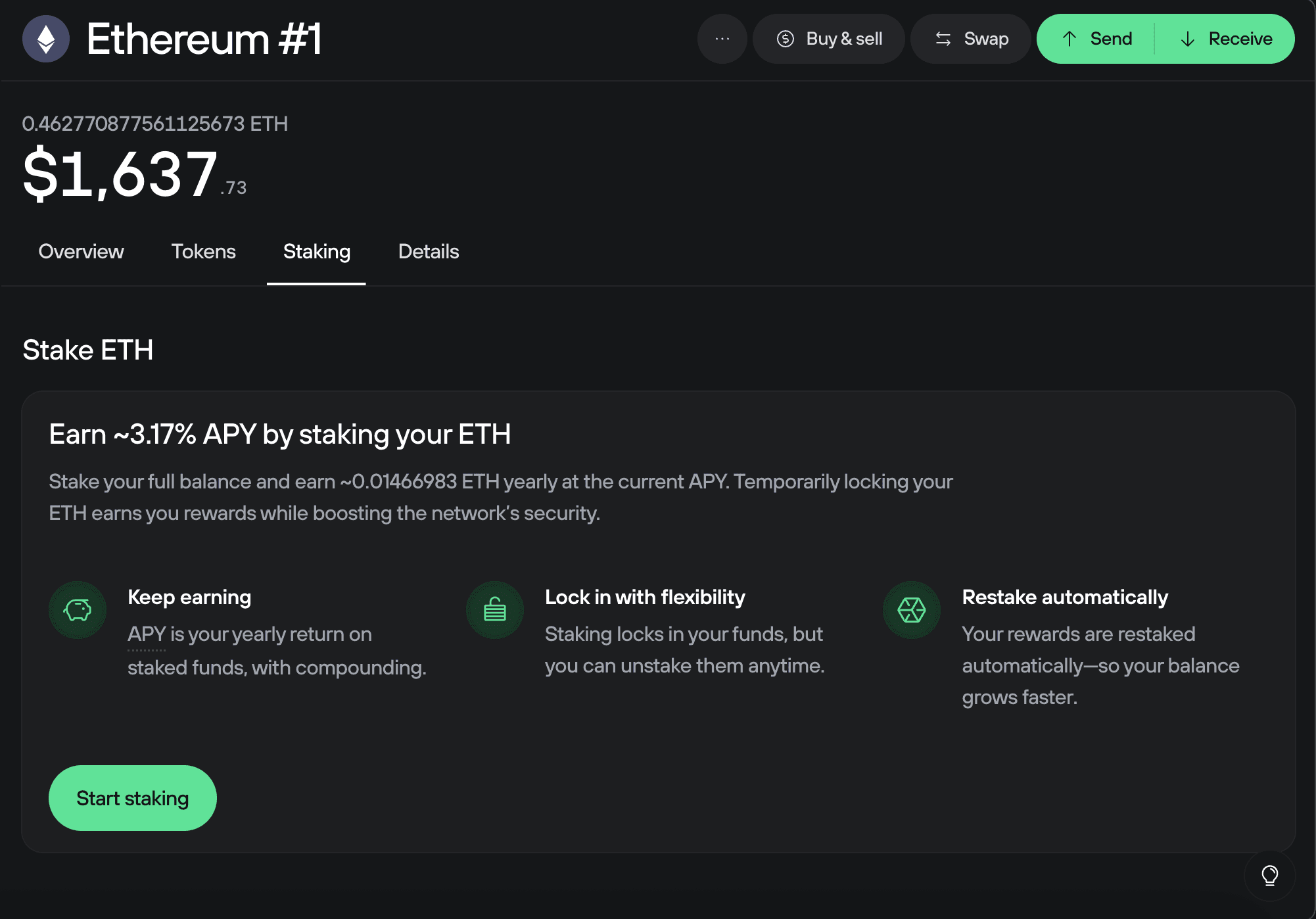
- First, you'll see the Staking in a nutshell window, which serves as a quick reminder of the key facts related to staking ETH:
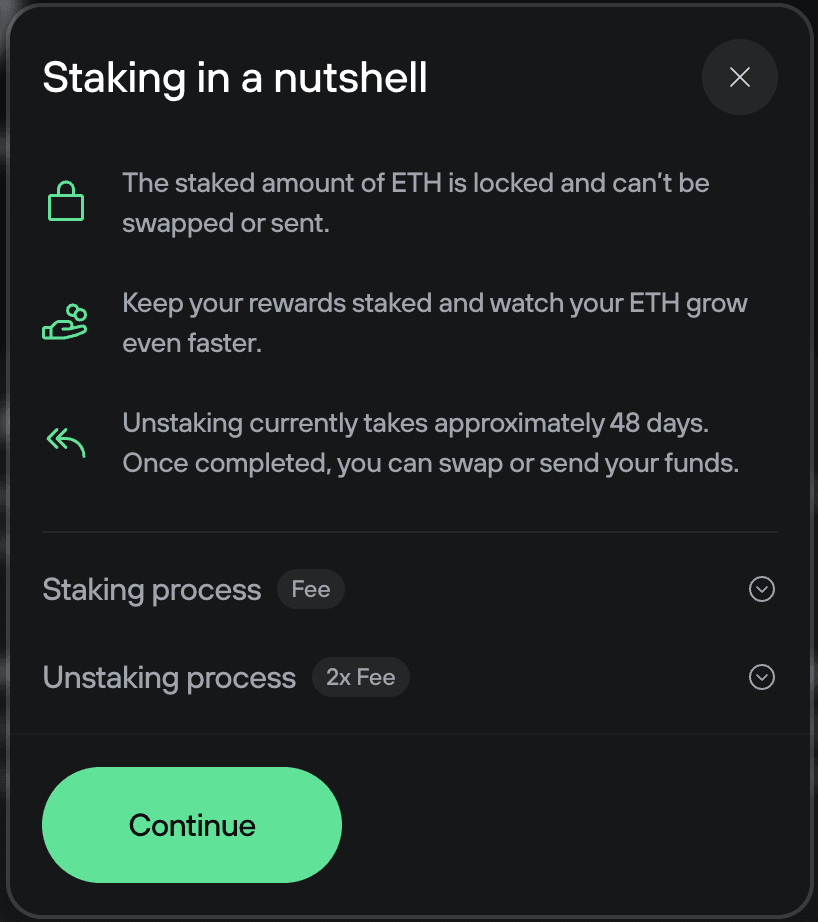
- After you've clicked on Got it!, you will then need to give consent for your staked funds to be maintained by Everstake:
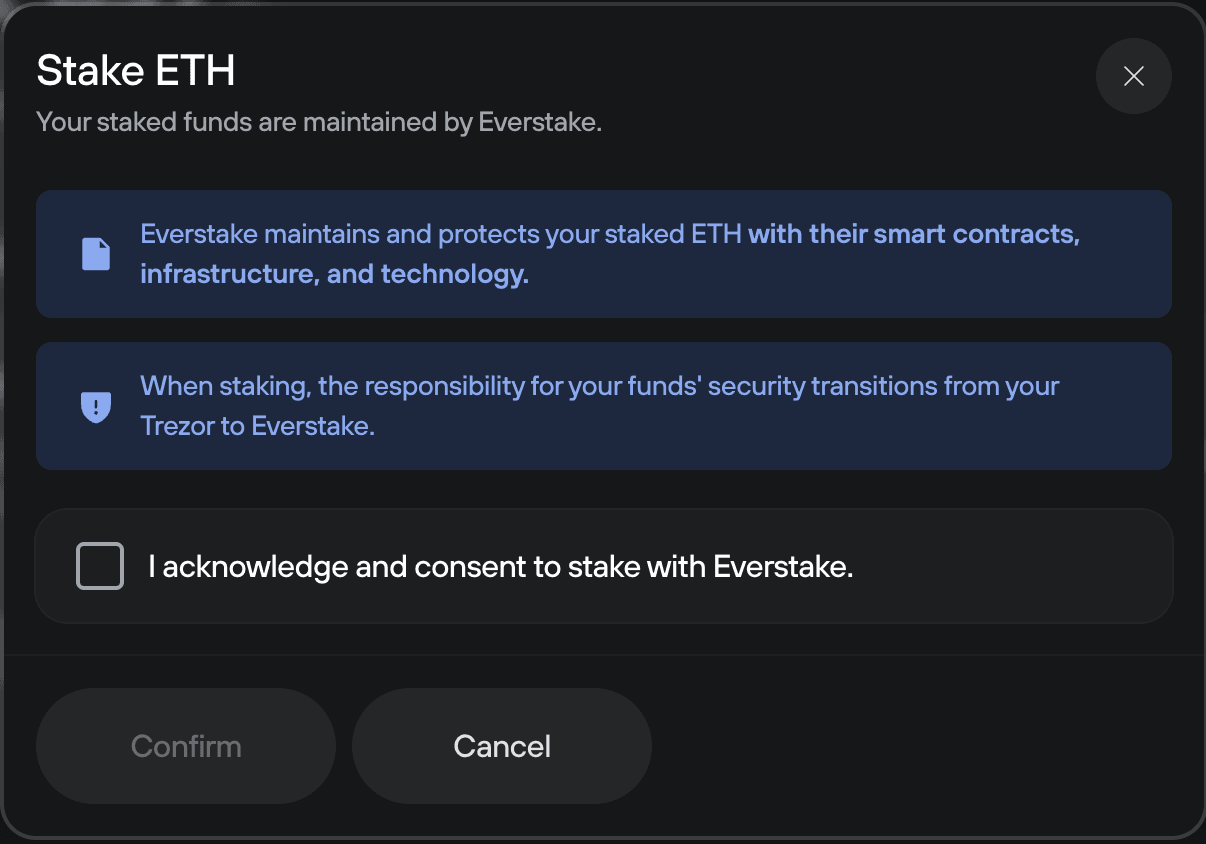
- You will then be presented with the Stake Ethereum window. You can set the amount you wish to stake by entering the value in ETH or in your favoured currency:
Remember, you need at least 0.1 ETH to delegate your funds to the Everstake stake pool.
- Once you've entered the amount you wish to stake, select Continue.
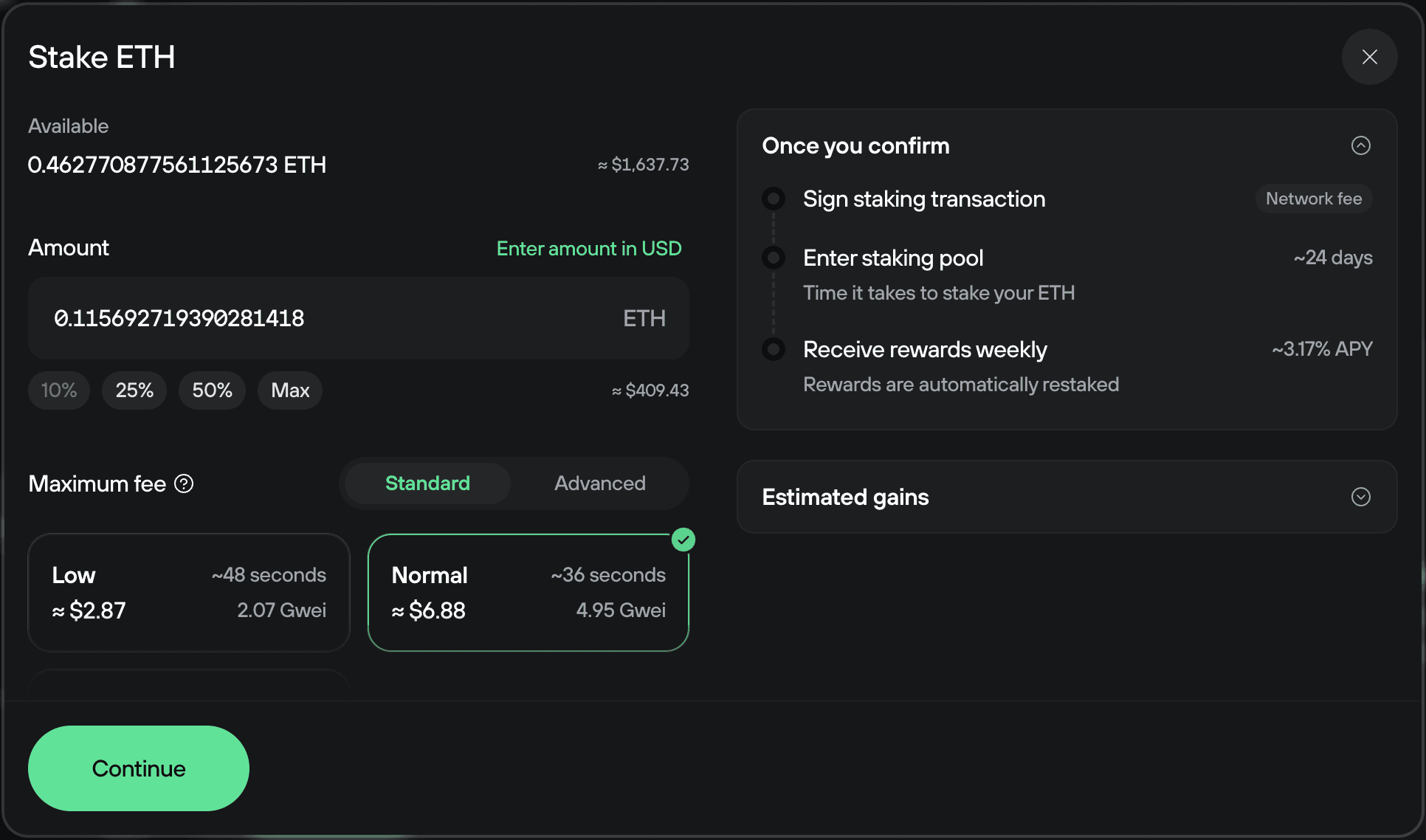
- In the Confirm entry period window, check the box to acknowledge the conditions, and then select Confirm & stake:
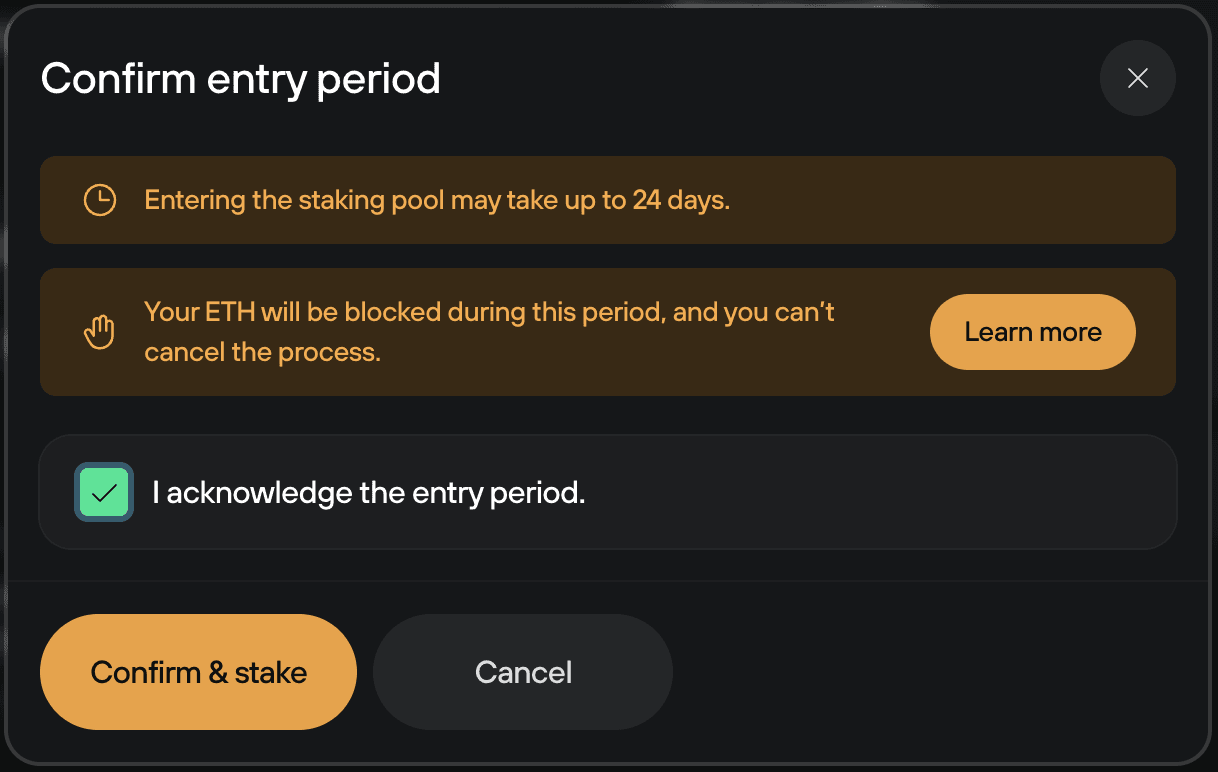
- Confirm on your Trezor device the prompt to “Stake [the amount of ETH you wish to stake] on Everstake?”
- Confirm the total amount and gas fee on your Trezor device.
- You can then select Stake in Trezor Suite.
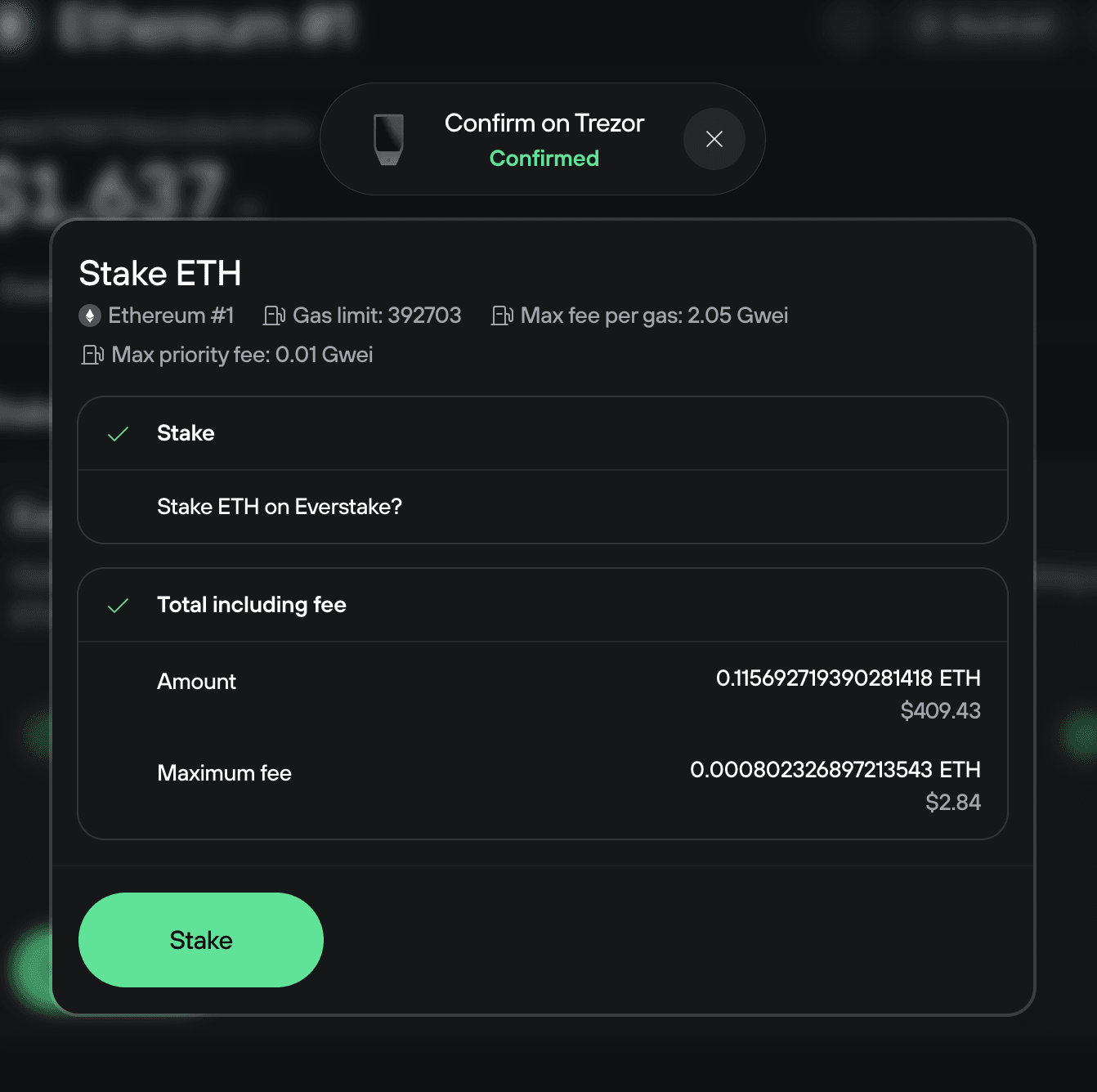
- That's it! You've started staking your ETH. After the transaction confirms on the network, your funds will enter the staking pool. This can be instant, or can take up to 24 hours depending on pool activity. Check the status of your staked ETH anytime in the Staking tab.
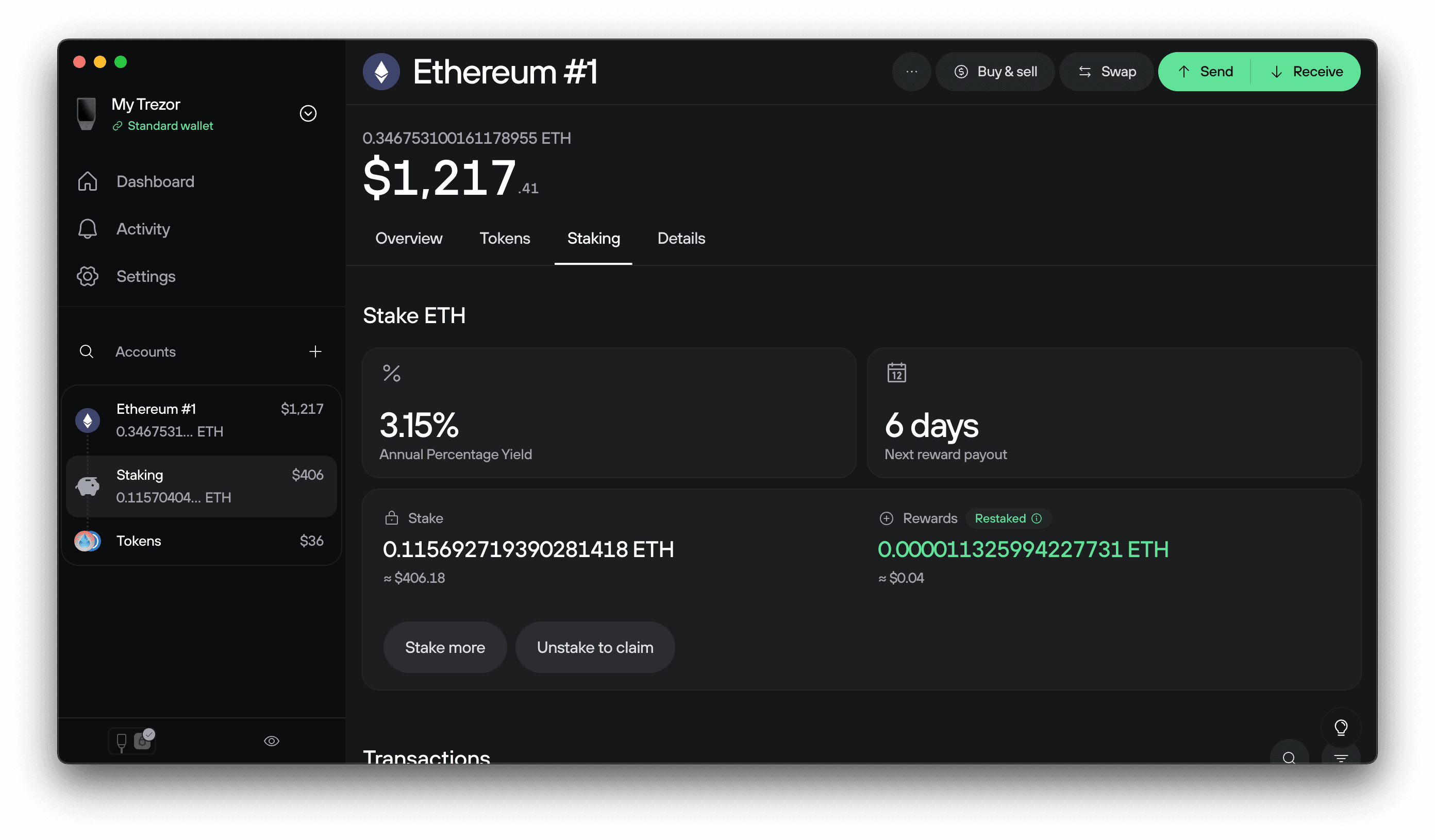
- Here you can check the status of your stake requests, alongside other options such as Stake more (i.e. increase your staking delegation) and Unstake to claim (begin the process of unstaking your ETH).
How does unstaking work in Trezor Suite?
It only takes a few steps to move your ETH (plus any rewards) from the Everstake pool back to your Trezor:
- Go to the Ethereum Staking tab, where you will see a breakdown of your staking activity. Click on Unstake to claim.
- Set the amount of ETH you'd like to unstake, and set a custom fee if desired. Then select Unstake.
- Confirm on your Trezor device the prompt to “Unstake [the amount of ETH you wish to unstake] from Everstake?”
- Confirm on your Trezor device the prompt to “Really send message” and the gas fee.
- You can then select Unstake in Trezor Suite.
- Once the unstaking is complete, you will then be able to Claim your funds instantly.